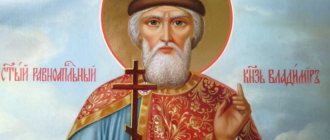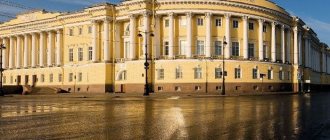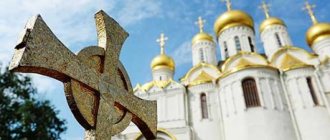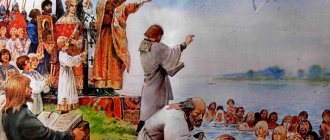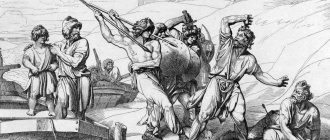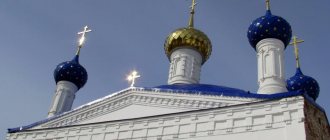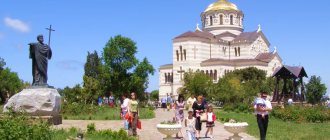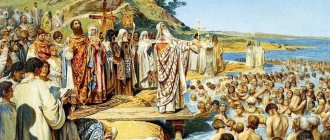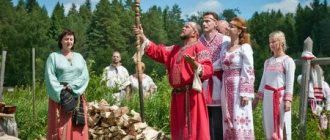Brief facts about the essence and meaning.
The baptism of Rus' by Vladimir I Svyatoslavich took place in 988 and became the reason why the Grand Duke was subsequently given the nicknames “Saint” and “Baptist”. Fratricide, numerous vices described in the chronicles - all this “went away”, one had only to be baptized and try to spread Christianity among his subjects, according to the conditions of marriage with the Byzantine princess Anna.
The introduction of Christianity in Rus' took place in several stages:
-at the first in Chersonesos, the prince and part of his squad were baptized himself;
-on the second - he baptized those living in Kyiv and ordered the destruction of the pantheon of Slavic gods in the city;
-on the third, by order of Vladimir, his governor Dobrynya baptized Novgorod “with fire and sword.”
Despite the chronicle’s statement that “the whole Russian land was baptized,” many tribes refused to leave the faith of their ancestors and for a long time raised uprisings (for example, Vyatichi).
Attitude and national identity
The paganism of the ancient Slavs was a rather cruel religion. Christianity proclaimed new values:
- virtuous life;
- humility;
- repentance;
- love for one's neighbor.
In the 11th century, the first Russian saints appeared: princes Boris and Gleb, who died as a result of fratricidal civil strife.
Rice. 2. Saints Boris and Gleb. Pskov icon. XIV century.
Briefly about the consequences of the adoption of baptism by Russia is the fact that in the most difficult times the church always made an ardent call for national unification and the fight against foreign invaders. These patriots were:
- Sergius of Radonezh (Tatar-Mongol yoke):
- Patriarch Hermogenes (Time of Troubles);
- Patriarch Sergius (Great Patriotic War).
Even the convinced atheist Stalin during the Great Patriotic War considered it necessary to meet with Russian metropolitans, after which the Russian Orthodox Church was partially legalized.
After the fall of Constantinople in 1453, Russia becomes the largest Orthodox state in the world. As a result, a great power idea emerges - “Moscow is the third Rome.”
Prerequisites.
Prince Vladimir I was not the first among the Rurikovichs who tried to promote Christianity in Rus'. Before him, his grandmother, Princess Olga, tried to complete this task.
Returning from Constantinople baptized in 957, she began to urge her subjects to change their faith, but met strong resistance both among the common people and from her own son Svyatoslav Igorevich. Nevertheless, Christians were present in Kiev both before Olga and after her - in the treaty with Byzantium in 945, they took a separate oath in their own church, and during the reign of Vladimir, a legend is described about the martyrdom of two Christians at the hands of “pagans.”
Consequences of the Christianization of Rus'
When the Russians adopted Christianity, this was reflected not only in the nature of worship services and sermons, but also in the set of accepted norms and new institutions. In 1037, the “barbarian” state received its first metropolitan, Theopompus, and the son of Prince Vladimir, Yaroslav the Wise, began the construction of the metropolis. Local church administration began to be carried out through the bishopric, subordinate to the metropolitan, whose authority now oversaw the entire clergy of Rus'. The churches received ownership of the lands on which they farmed, following Byzantine customs and laws, under which legal relations with farmers were established, as in Greece.
In a short time, the Russian church began to represent a powerful mechanism in the spiritual and social life of the state. Under her constant supervision, schools were erected everywhere, in which the clergy themselves acted as teachers. The monastery walls represented the focus of cultural and educational centers, where the works of chroniclers, translators, philosophers were born and the first national books were written. Using the example of their Greek colleagues, the clergy governed and judged people based on the collection of laws of the Nomocanon, which acquired the name The Pilot's Book. The crimes committed and the immorality of the flock replenished the church treasury with good income. In addition to the main tithe from the population, donations from high-born parishioners could be expressed in gold and silver, lands and lands, villages and cities.
It is worth adding that, despite the Byzantine influence, Kievan Rus continued to preserve the originality of its culture.
Promotion of Christianity
According to the chronicles, Vladimir first tried to formalize the disparate beliefs of the tribes into a single pagan pantheon and thus consolidate the state around Kyiv: on one of the hills of the city, statues of Slavic gods were installed, among which Perun the Thunderer stood out, because It was he who was the patron saint of warriors. The failure of this event, caused by the reluctance of different tribes to cede the primacy of the worship of the gods they already loved to another, is called by historians one of the reasons for the adoption of Christianity by the Grand Duke.
Reasons for accepting Christianity.
According to the Tale of Bygone Years, before the baptism of Prince Vladimir, a “test of faith” took place.
In 986, ambassadors from the Muslim Volga Bulgars, Germans (foreigners) from Rome sent by the Pope, and Khazar Jews arrived to Prince Vladimir. All three delegations did not make the proper impression on the prince.
Then a Byzantine arrived in Rus', whom the Russian chronicler called the Philosopher for his wisdom. He told the Russian prince about biblical history and the Christian faith. However, Vladimir had not yet made a final decision and, on the advice of his closest boyars, sent an embassy to Constantinople, which returned greatly impressed by Christian rituals.
Finally, another reason for the adoption of Christianity was the condition of the Byzantine emperors, from whom Vladimir demanded his sister as his wife - the Grand Duke undertook to be baptized himself and spread Christianity among his subjects, only in this case Princess Anna became his wife.
Thus, we can list the following generally accepted reasons for the adoption of Christianity in Rus':
-Vladimir needed a religion that united different tribes; the old faith, in his opinion, could not fulfill this task.
-Of the Muslim, Catholic, Jewish and Greek religious embassies, only the last impressed him.
-Christianity made it possible to build a rigid vertical of power, postulating the “divine” origin of princely power and the need to submit to it, while the Slavic faith implied equal kinship to the gods among all representatives of the people.
-The transition of the prince to the new faith and the subsequent Baptism of Rus' was a prerequisite for the marriage between Vladimir I Svyatoslavich and Princess Anna.
The influence of Christianity on the culture of Ancient Rus'
The emergence of Christianity with its rich traditions could not but influence the culture of the Slavs. The new faith required new rituals - and temples and monasteries were actively built throughout the country. Temple architecture, which initially copied the Byzantine style, very quickly came under the influence of the original Slavic traditions. And the monuments of ancient architecture clearly demonstrate this. A good example of such influence is the St. Sophia Cathedral in Novgorod.
Christianization also opened the doors to literary creativity. Thanks to the works of Cyril and Methodius, worship was conducted in a language understandable to everyone, and accordingly, all church literature was also translated into Old Church Slavonic. Very quickly, monasteries and churches acquired their own libraries, and not all of the works in them were translated - Rus' had its own authors of spiritual literature.
With the spread of writing, history also received an impetus for development. Recording current events or chronicling became a voluntary duty of Orthodox monks. That is why written evidence has reached us about the formation of Christianity and the development of Russian statehood from the 10th to 12th centuries.
But Christianity played its main role in the process of unification of Rus'. Orthodoxy became the core around which a single nation began to form from disparate Slavic tribes. The spiritual, cultural, social unity that Christianity provided became a catalyst for the unification of Rus', the creation of a single state with a single people on its territory.
Baptism of Vladimir in Korsun (Chersonese).
After the capture of the Byzantine city of Korsun in 988, Vladimir sent a demand to Emperors Basil and Constantine:
“Your glorious city has already been taken; I heard that you have a maiden sister; If you don’t give it up for me, then I will do to your capital the same as I did to this city.”
(from the Tale of Bygone Years)
The rulers of Constantinople put forward a counter-demand for the baptism of Vladimir, his squad and all his subjects, to which the Grand Duke agreed. As a result of much persuasion, Princess Anna agreed to the marriage in order to rid Byzantium of the constant raids of the Rus and headed by sea towards Chersonese.
Upon Anna's arrival, Vladimir became blind due to an unknown illness, and the princess advised him to immediately be baptized for healing. According to the chronicle, the prince, who received his sight after baptism, exclaimed:
“Now I know the true God”
(from the Tale of Bygone Years).
Following the prince, most of his squad was baptized.
After this, Vladimir returned Korsun to the Greeks and, together with his new wife, went to Kyiv. The chronicler separately notes that the prince took out from Korsun the relics of saints and icons, as well as other trophies, including all kinds of utensils and copper statues.
Test on the topic
- Question 1 of 5
In what century did the first Russian saints appear?
Start test (new tab)
Hall of Fame
To get here, take the test.
-
- Zlata Volova
5/5
- Ilya Pertsev
5/5
- Vitaly Bausina
5/5
- Egor Yashin
4/5
- Konstantin Kostin
5/5
Baptism of Kievites.
Arriving in Kyiv, Vladimir ordered to topple the statue of Perun, which had been installed earlier on his order, and then subject the Slavic god to desecration.
The temples of other gods suffered the same fate - they were destroyed, the statues were burned. Soon, on the hill where the Slavic pantheon had previously been located, Vladimir ordered the construction of a church.
Amid the cries of the townspeople outraged by the violation of the faith of the ancestors of the townspeople, the statue of Perun was thrown into the Dnieper River and, by order of the Grand Duke, several people with poles did not allow it to wash ashore until it passed the rapids. In the city, Vladimir ordered heralds to go around and voice his order:
“If anyone does not come to the river tomorrow - be it rich, or poor, or beggar, or slave - he will be my enemy.”
(from the Tale of Bygone Years)
Some, according to the chronicle, left the city for the forests, not wanting to accept the new religion, but most of the townspeople the next day came to the banks of the Dnieper to undergo the baptismal ceremony.
Chapter Three. Christianity in Russia from the baptism of Rus' to the accession of Peter the Great. (988 – 1682)
At the end of the 17th century, Russia was shocked by the cultural and political revolution started by Peter I. It ended a long period of our history associated with the primacy of Moscow in the life of the Russian people, which began with the reign of Ivan Kalita (1328–1341) and ended with the reign of Fyodor Alekseevich Romanov ( 1676–1682).
Before moving on to a description of the position of the Church in the era of the St. Petersburg Empire, it is useful to summarize at least a brief summary of both the achievements and failures that marked the history of Muscovite Rus'. This was a time when the Orthodox Church was the main, if not the only, teacher and inspirer of the Russian people, and therefore it is often held responsible for the state of Russia in these centuries.
Let's start by describing its shortcomings. Many of them are striking, and Russian Westerners of modern times usually harshly judge pre-Petrine Rus', calling it a backward and unenlightened country of humiliated serfs and arrogant boyars. This attitude towards Russia finds its justification in descriptions of Moscow in the 16th and 17th centuries, written by foreign visitors. They paint the life and morals of the Russian people in the darkest colors, marveling at their ignorance, complaining about! his tendency to cheat, to intemperance in eating and drinking and to his uncleanliness. The entire Russian way of life seemed to foreigners to be difficult, clumsy, killing will and reason and making Russians cowardly slaves of their princes and tsars. Most of these writers did not know the Russian language; they looked down on the peculiarities of Russian life and treated the beliefs and rituals of Orthodoxy with contempt. Therefore, they cannot be considered impartial and reliable witnesses of our past.
These writers hostile to Russia did not want to see the positive sides of Moscow life, but they never missed any of its shortcomings. Despite this, we, the descendants of Moscow Rus', need to be attentive to the assessment of these harsh judges; we have a duty to study our past, not turn a blind eye to its dark sides, at the same time, we must look for explanations of the reasons that made it so difficult for the Russian people the struggle to improve their existence. It should be remembered that our ancestors lived under constant threat. Their main enemy was the same steppe nomads who destroyed the Kiev state. Rarely a year passed when their surprise attack did not hit one or another region of the Muscovite kingdom. Every year, thousands of Russian men, women and children, captured in their villages and cities by merciless steppe riders, were sold as slaves in the markets of Turkey. The Russian people bled continuously, and this continued until the end of the 18th century. Only after the annexation of Crimea in 1783 did Tatar attacks on Russian soil stop.
In order to successfully fight this danger, the Russians needed to improve their military equipment, to boost industry and trade, but they were deprived of the opportunity to achieve this goal, since their neighbors - the Poles, Lithuanians, Germans and Swedes, closed them access to Europe, keeping Moscow artificially cut off from the West. The Russian people were therefore forced to maintain poorly armed guards along the entire length of their huge, difficult to defend border and wage exhausting wars with. by your enemies. If they managed to regain their ancestral regions from Poland, then the Swedes or Tatars immediately struck them in the rear, depriving them of the fruits of their victory. If the Russians went against the Tatars, then they were attacked from the West by Lithuania and Poland. This continuous struggle required such spiritual and physical stress that the Russian people did not have enough strength or opportunity for that education, for those achievements in the field of science and art with which Europe adorned itself in those same centuries.
But the entire blame for Russia’s backwardness should not be placed on external circumstances alone. And the Russians themselves were largely to blame. The main vice of the Muscovite Kingdom was the remnants of slavery that had become ingrained in Russian life during the years of the Tatar yoke. Lack of rights and arbitrariness destroy a person’s sense of respect for others and for himself, undermine his consciousness of responsibility for his actions and recognition of the right of another person to direct his life and activities according to his will. The slave suffers from the tyranny of his master and therefore, receiving freedom, often becomes a tyrant of other people. The Russian people were slaves of their princes and kings, they did not recognize themselves as citizens of their state, and this was the main obstacle that prevented the improvement of their civil system. They were all members of the Church, each of them belonged to their own clan, and thus they were all connected with each other, making up one big family. But the Russian land itself was considered by them as the private property of the Moscow tsars, and all those who lived and worked on it considered themselves only his servants. Some of them, such as princes and boyars, occupied important and honorable positions, others, like townspeople and taxation people, performed difficult “menial” work, but none of them felt like the true master of their land. Therefore, if one of them was dissatisfied with his situation, he usually left his home and looked for a new refuge in the vast expanses of his homeland, in the hope of improving his life there.
The Russian people, instead of making concerted efforts to alleviate their situation, preferred to “wander separately,” avoid responsibility, and be runners rather than builders. So his best commander, Prince Andrei Kurbsky, fled from Ivan the Terrible to Lithuania, so countless servicemen and townspeople and peasants fled across the Volga to the Urals, to the Cossacks on the Don, to distant Siberia, and this temptation by space made the fate of those who remained even more difficult and hindered growth of Russia. Lack of civic courage, cohesion and awareness of their rights and responsibilities were the main vices of the Moscow population. On this basis grew the oppression of the lower classes, the arbitrariness of those in power, bribery and judicial red tape, from which all Russian people suffered without exception, and which prevented them from raising the well-being of their country. These were the main shortcomings of Muscovite Rus', but along with them it could boast of great achievements.
The main one was a correct sense of the true values of life. The Russian people of that time knew what should be considered important and what was secondary, and this gave them that clarity of spirit, that inner balance that many of them lost after the uncritical imitation of the West began.
Muscovite Rus' built its social life on the recognition of the importance and necessity of “rite.” This word denoted not only the actions of the clergy and laity during Divine services, but also their everyday customs and habits. All Moscow life required adherence to strictly defined rules, which indicated how one should behave in church, at home, when visiting, how one should treat one’s parents, wife, children, servants and acquaintances, what food could be eaten on various days of the church year . This everyday piety, which could seem to an outside observer to be a heavy yoke imposed on the life of the Russian people, constraining their personal freedom at every step, was, on the contrary, a source of inspiration for the Muscovite people, for it gave meaning to his existence. The ritual was so lovingly, so carefully observed by the Russian people, because they believed that with its help it was possible to recreate the “image” of God in themselves. God, the Creator of the world, created man in His Image and His Likeness41, and as like His Creator, man was given the opportunity to partake of the glory of the Kingdom of the Holy Trinity. But in order to enter as a full participant in the indescribable joy of the New and Reborn life, a person had to cleanse and renew in himself the Image of God, darkened by his selfhood and sin.
According to the belief of Muscovite Rus', the ritual was a God-given means for restoring the Image of God in the fallen creation. And since man was created by God from the earth, that is, he was rational and spiritualized matter, then the renewal of the Image of God in him concerned not only his spiritual essence, but also included the transformation of the flesh, its enlightenment and submission to the highest dictates of free and loving spirit. In rituals, a person not only raised his personality to the highest level of meaningful existence, but he also introduced the entire physical world, which was part of his bodily nature, to the glory and joy of the Holy Trinity.
This special experience of the transformation of all creation was most clearly expressed by Muscovite Russia in its icon painting and church architecture. Man and the surrounding universe, depicted on the icons, were involved in the mystery of their future glorification. To a person unfamiliar with the worldview of the Orthodox Church, the faces and bodies of the Saints may seem frozen in a strange stillness. But this restraint in the movements of the Righteous does not mean denial or contempt for the flesh, but, on the contrary, serves as clear evidence of its voluntary submission to the dictates of the spirit. The achieved power over the body appears especially clearly in the expressions of the eyes of the Reverends, directed at that heavenly transfigured world, the sweetness of which the Saints are given a foretaste already on this earth. The luminous reflection of the new jubilant universe burns with bright colors on the crowns and clothes of people depicted on Orthodox icons, and under its rays all the surrounding nature is transformed, which, following its human master, tremblingly rises to its creator, anticipating the glory of its renewal and liberation. The multi-colored domes of Russian churches with their victorious, golden crosses burning in the sun speak about the same thing. Eyes, like lit candles or flowers of paradise, grow on the long-suffering earth, where it is sprinkled with the grace of the Holy Spirit, sanctifying matter in the Sacrament of the Eucharist.
On the wide Russian plain, poor and wretched, during the time of Muscovite Rus', countless Orthodox churches rose to the sky, glorifying God. They expressed the faith of the people who built them Ht not only in the Truth of the Incarnation, but also in the victory of light over darkness, love over hatred and unity over division. The Russian people discovered the cosmic meaning of Christianity, which Western humanity had passed by, and that is why the icons they painted, the churches they built, the rituals they so lovingly observed bore the stamp of genuine revelation. The art of the Moscow Kingdom proclaimed to the whole world the faith of its often nameless creators in the great task entrusted to man by God.
The man of Moscow Rus' lived by faith, and it made him hardy and persistent. No matter what disasters befell him, no matter how cruel and strong his opponents were, he did not lose his hope and continued, despite seemingly insurmountable obstacles, to fight for his existence, and to rebuild again his temples, cities and villages, erased from the face of the earth with fire or the sword of his many enemies. He was capable of this because he knew that life does not end with physical death, that whoever kills the body cannot kill the soul, and that the triumph of love and truth is ensured by what happened once and for all on the Night of the Resurrection of Christ. No nation knows how to rejoice at Easter as much as the Russian people do, and it is not for nothing that our language calls Sunday the weekly rest from work and worries.
Such were the achievements of Orthodox Russian culture. Its best bearers, such as Righteous Yulia Lazarevskaya († 1604), the noblewoman Theodosius Morozova († 1672), the fiery Archpriest Avvakum († 1682) and his no less daring priest Anastasia Markovna, the enlightened and humble courtier boyar Fyodor Rtishchev († 1673) from many other righteous men and women, constitute the glory of the Russian people. Even though Muscovite Rus' was backward compared to Europe in the field of weapons and technology, it could stand comparison with any country in the spiritual enlightenment of its best people, in their sensitivity, mercy and deep knowledge of the true values of life. She possessed that special wisdom that she passed on to post-Petrine Russia, and which still makes an Orthodox Russian person responsive to the misfortune of others and capable of such sacrifices that seem beyond the capabilities of other Christian peoples.
Baptism of Novgorod.
At the end of the 10th century, Novgorod was one of the most important cities of Rus', the main political, craft and trade center of the Russian North, a stronghold of the Slavic pagan religion. The Novgorod land was a vast region, rich in furs, forests, fish, and iron ore deposits. Its population paid tribute and supplied the great Russian princes with warriors for campaigns. Vladimir Svyatoslavich entrusted the responsible task of baptizing the Novgorod lands to his closest adviser, Voivode Dobrynya, as well as Voivode Putyata, who was assigned to him for reinforcement.
The preaching of the new religion did not evoke sympathy among the majority of Novgorodians. By the time Bishop Joachim arrived in Novgorod, the situation there was tense to the limit. Having learned that Dobrynya was approaching the city with significant forces, the pagans held a meeting, at which they decided not to let the Christian army into the city and “not to allow the idols to be refuted.”
Due to their numerical superiority, the Novgorodians had a good chance to drive Dobrynya out of the city, but at a certain point in the confrontation, Dobrynya ordered houses on the western side of Novgorod to be set on fire. The flames quickly spread throughout the wooden city and affected the homes of many residents. Most of the Novgorodians rushed to save their property, family, where else they could - at home.
Having agreed to a cessation of hostilities under the threat of new arson, the Novgorodians allowed to preach Christianity and build churches in the city, but stubbornly refused to be baptized. A categorical order followed to baptize Dobrynya by force...
In addition, in order to completely eradicate paganism and create conditions for the new faith to take root, it was necessary to destroy the temples, and above all the main shrine of the Novgorodians - the Temple of Perun. The soldiers of the Kyiv governor destroyed the temple, and the statue of Perun, just like in Kyiv, was removed from its place and dragged to the river, while hitting it with sticks. Other pagan sanctuaries shared the fate of the main place of worship of Perun.
Later, the people of Kiev, proud that the introduction of Christianity went more or less smoothly, maliciously reminded the Novgorodians: “Putyata baptized you with a sword, and Dobrynya with fire.”
Further spread of Christianity in Rus'
In some territories, Christianity was imposed by force; At the same time, religious buildings of the pagans were destroyed, and those who resisted were subjected to repression.
In Rostov and Murom, resistance to the introduction of Christianity, according to traditional church history, continued until the 12th century: the first two bishops sent to Rostov were expelled. Resistance to baptism was also one of the factors strengthening the Slavic colonization of North-Eastern Rus', into which staunch adherents of paganism moved.
Reasons for the need for Christianization
Before moving on to analyzing the consequences of Christianization, it is necessary to find out what were the prerequisites for making such an important decision.
, idolatry was widespread in the territory of Kievan Rus . The many tribes that were part of the state worshiped different deities and adhered to their own religious laws. Sources that have survived to the present day list Perun, Dazhdbog, Khors, Simargl, Yarilo, Mokosh, etc. The worship of some of them involved bloody sacrifices.
Constantly exposed to raids by nomads, the state needed to unite the tribes. Only the powerful force of faith in something united could contribute to this process. Therefore, Vladimir Krasnoe Solnyshko chose the religious “leverage of influence” to strengthen the interrelations of the tribes and strengthen his own power. In pagan times, the prince was just a military leader who could be overthrown or killed.
In 980, Vladimir tried to create a religious pagan center in Kyiv. For this purpose, a huge temple was built, where idols of the six most revered gods were located. But the reform did not bring the desired result: the tribes continued to worship their deities. The adoption of faith in one God became a necessity.
The international situation played an important role in the decision to Christianize Kievan Rus. In order to create and strengthen economic ties with neighboring states, it is necessary to have common ideological and religious views with these countries. And most European countries professed monotheism (belief in one God). There were several directions of monotheism in Europe:
- Christianity (Byzantium, Germany, Danube Bulgaria and Moravia).
- Islam (Volga Bulgaria and the Arab Caliphate).
- Judaism (Khazar Khaganate).
Vadimir understood that if he did not soon establish a single religion on the territory of the state, then Kievan Rus would be fragmented according to religion into several parts, and this could provoke the collapse of the state.
Dynastic marriages with representatives of other countries were of no small importance for expanding territorial borders and strengthening political and economic relations. This was another significant reason for the need for Christianization of Kievan Rus.
